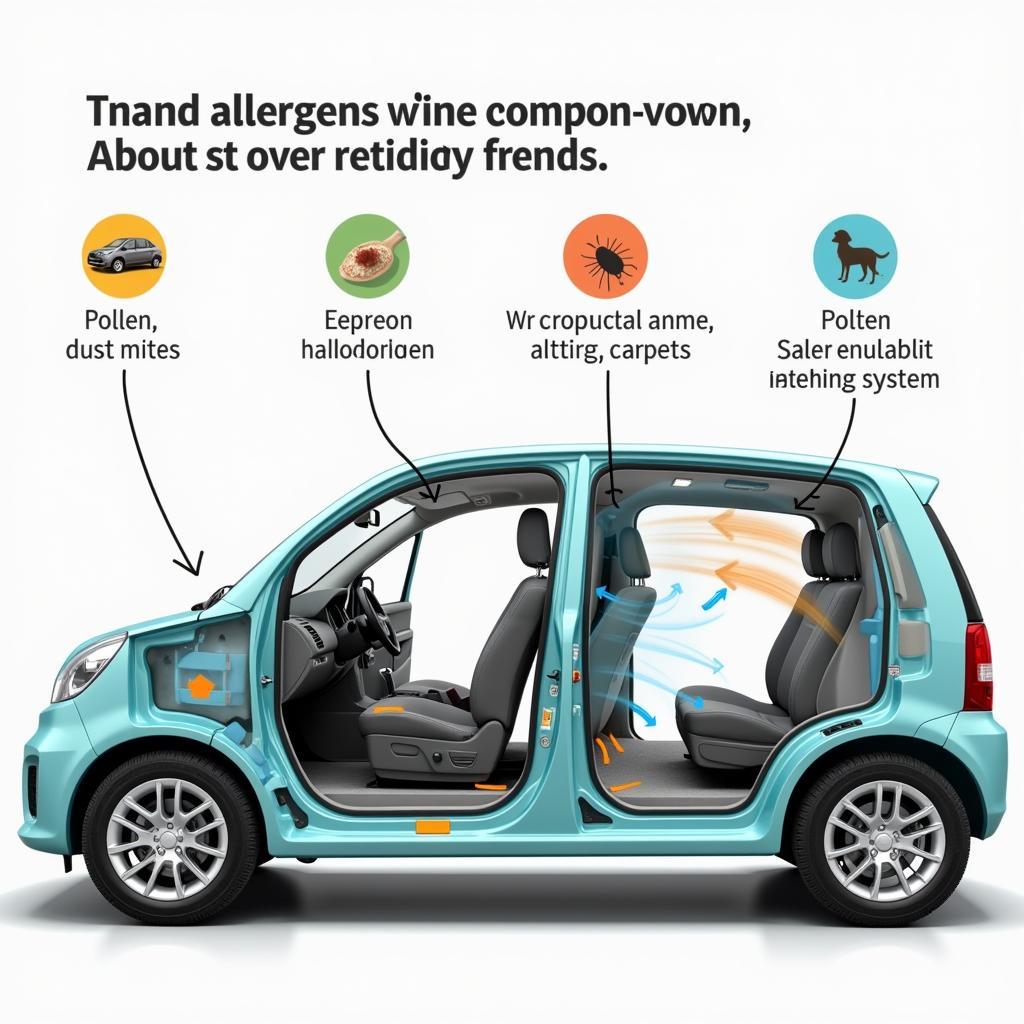Does Car Riding Aggravate Problem Nasal Membranes? For many, the simple act of driving can turn into a sneezing fit, a stuffy nose, or a headache. This isn’t just a coincidence. The environment inside your car can significantly impact pre-existing nasal issues, often exacerbating them. Let’s explore the connection between your car and your nasal health.
Why Does My Car Seem to Make My Nasal Problems Worse?
Several factors within your vehicle can contribute to nasal irritation. These range from the obvious culprits like pollen and dust to less apparent issues like the car’s ventilation system and the materials used in the interior.
Air Quality Inside Your Vehicle
One of the primary reasons car riding aggravates problem nasal membranes is the air quality within the confined space of your vehicle. Allergens like pollen, dust mites, and pet dander can easily become trapped inside, leading to increased exposure and subsequent irritation. Furthermore, exhaust fumes from other vehicles can infiltrate the cabin, further compromising air quality and triggering nasal inflammation.
- Pollens and other airborne allergens: When you drive with your windows down, pollen and other allergens can quickly enter your car, clinging to upholstery and circulating through the ventilation system. Even with the windows up, these particles can find their way in through the vents.
- Dust mites: These microscopic creatures thrive in warm, dusty environments like car interiors, especially in the seats and carpets. Their droppings are a common allergen that can significantly irritate nasal passages.
- Pet dander: If you frequently travel with pets, their dander can accumulate in your car, even if you don’t see it. Pet dander is a potent allergen for many people, contributing to nasal congestion and other allergy symptoms.
- Exhaust fumes: Inhaling exhaust fumes, particularly in heavy traffic, can irritate the nasal passages and lungs. This can be especially problematic for individuals with pre-existing respiratory conditions.
 How Car Interior Air Quality Affects Nasal Membranes
How Car Interior Air Quality Affects Nasal Membranes
The Role of Your Car’s Ventilation System
Your car’s ventilation system, while designed to circulate fresh air, can sometimes worsen nasal problems. If the system isn’t properly maintained, it can become a breeding ground for mold and mildew, which release spores that irritate the nasal passages. A dirty cabin air filter can also exacerbate the problem by failing to effectively filter out allergens and pollutants.
- Mold and mildew: These fungi thrive in damp, dark environments like the inside of your car’s air conditioning system. If your AC emits a musty odor, it’s a sign that mold or mildew might be present.
- Dirty cabin air filter: The cabin air filter is responsible for removing pollutants and allergens from the air entering your car. A clogged filter not only reduces airflow but also allows more irritants to circulate within the cabin.
“A neglected cabin air filter is a recipe for nasal discomfort,” says Dr. Emily Carter, a leading allergist and immunologist. “Regularly replacing your cabin air filter, ideally every 12,000 to 15,000 miles, is crucial for maintaining good air quality inside your vehicle.”
Materials and Chemicals Inside Your Car
The materials used in your car’s interior, such as plastics, adhesives, and fabrics, can release volatile organic compounds (VOCs). These chemicals can irritate the nasal passages and exacerbate existing nasal problems. “New car smell” is often attributed to these VOCs, and while it might be pleasant to some, it can trigger nasal irritation in others.
- VOCs: These chemicals are released from various materials in your car’s interior and can cause nasal irritation, headaches, and other health problems.
- New car smell: This distinct odor is a result of the off-gassing of VOCs from new materials in the car.
Managing Nasal Problems While Driving
So, what can you do to minimize nasal irritation while driving? Here are a few tips:
- Keep your car clean: Regularly vacuuming and cleaning the interior can significantly reduce the presence of dust mites, pet dander, and other allergens.
- Replace your cabin air filter: As mentioned earlier, a clean cabin air filter is crucial for maintaining good air quality inside your car.
- Use your car’s air conditioning system strategically: Using the AC with the recirculation setting can help filter out some pollutants. However, make sure to occasionally switch to fresh air intake to prevent the buildup of mold and mildew.
- Keep your windows closed, especially during high pollen counts: This can help prevent pollen and other airborne allergens from entering your car.
- Consider using an air purifier designed for cars: These devices can help remove allergens and pollutants from the air inside your vehicle.
“Maintaining a clean car interior and a well-maintained ventilation system can drastically improve your driving experience, especially if you suffer from nasal problems,” advises automotive expert, Mr. Michael Stevens, a seasoned mechanic with over 20 years of experience. He also suggests, “Investing in a quality car air purifier can provide an extra layer of protection against airborne irritants.”
Conclusion
Does car riding aggravate problem nasal membranes? Absolutely. However, by understanding the factors contributing to nasal irritation in your car and taking proactive steps to address them, you can significantly improve your comfort and well-being while on the road. Remember, a clean car is a happy nose! For further assistance or personalized advice, connect with us at AutoTipPro. Call us at +1 (641) 206-8880 or visit our office at 500 N St Mary’s St, San Antonio, TX 78205, United States. We are here to help!




Leave a Reply